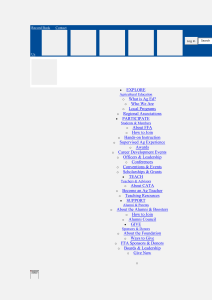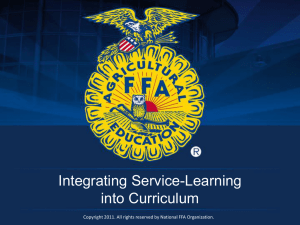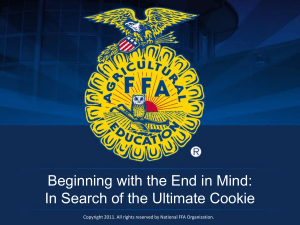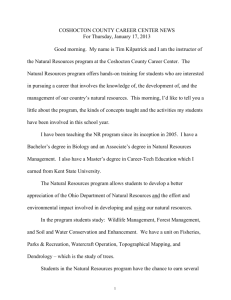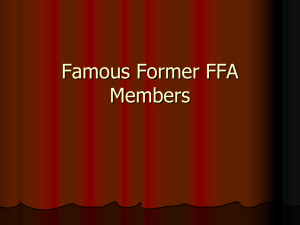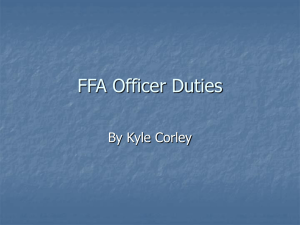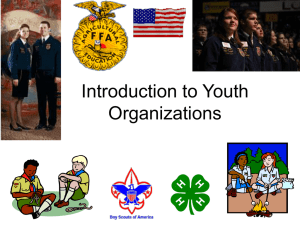Historical FFA Timeline
advertisement
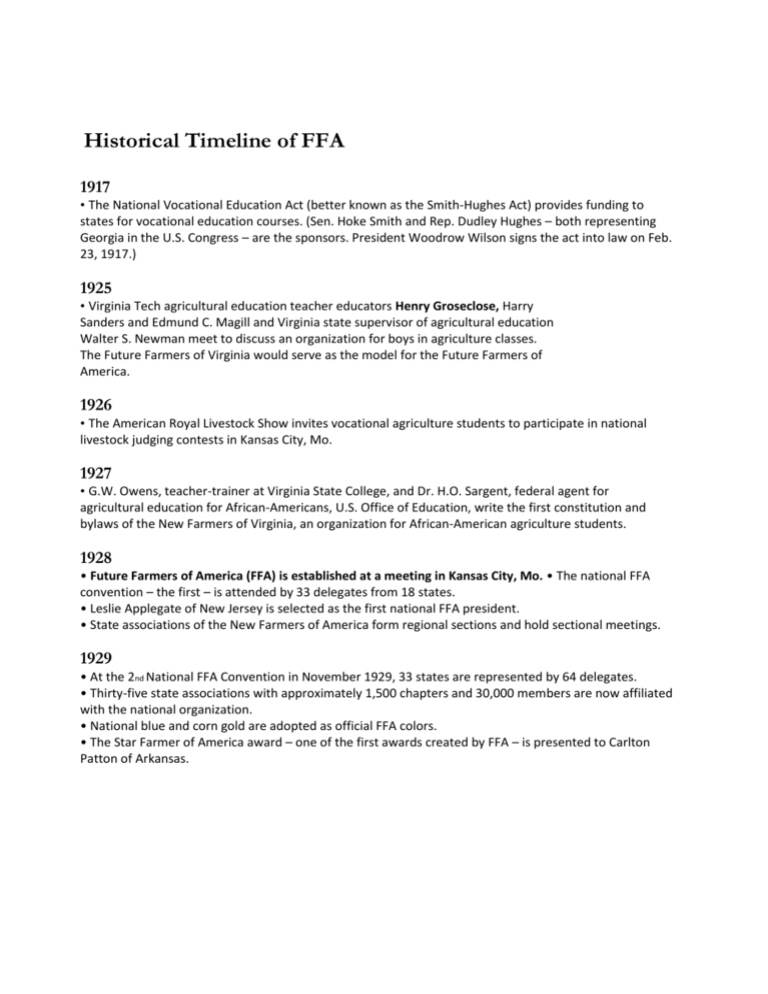
Historical Timeline of FFA 1917 • The National Vocational Education Act (better known as the Smith-Hughes Act) provides funding to states for vocational education courses. (Sen. Hoke Smith and Rep. Dudley Hughes – both representing Georgia in the U.S. Congress – are the sponsors. President Woodrow Wilson signs the act into law on Feb. 23, 1917.) 1925 • Virginia Tech agricultural education teacher educators Henry Groseclose, Harry Sanders and Edmund C. Magill and Virginia state supervisor of agricultural education Walter S. Newman meet to discuss an organization for boys in agriculture classes. The Future Farmers of Virginia would serve as the model for the Future Farmers of America. 1926 • The American Royal Livestock Show invites vocational agriculture students to participate in national livestock judging contests in Kansas City, Mo. 1927 • G.W. Owens, teacher-trainer at Virginia State College, and Dr. H.O. Sargent, federal agent for agricultural education for African-Americans, U.S. Office of Education, write the first constitution and bylaws of the New Farmers of Virginia, an organization for African-American agriculture students. 1928 • Future Farmers of America (FFA) is established at a meeting in Kansas City, Mo. • The national FFA convention – the first – is attended by 33 delegates from 18 states. • Leslie Applegate of New Jersey is selected as the first national FFA president. • State associations of the New Farmers of America form regional sections and hold sectional meetings. 1929 • At the 2nd National FFA Convention in November 1929, 33 states are represented by 64 delegates. • Thirty-five state associations with approximately 1,500 chapters and 30,000 members are now affiliated with the national organization. • National blue and corn gold are adopted as official FFA colors. • The Star Farmer of America award – one of the first awards created by FFA – is presented to Carlton Patton of Arkansas. 1930 • Official FFA Creed written by E.M. Tiffany is adopted. • First national public speaking event is held. Winner: Edward Drace, Missouri. • First Official Dress uniform is adopted: dark blue shirt, blue or white pants, blue cap and yellow tie. • Delegates restrict membership to boys only. • First official FFA manual is printed. 1933 • Blue corduroy jacket is adopted as official dress. • A group of FFA officers and members travel to Washington, D.C., where they are greeted on the White House lawn by President Franklin D. Roosevelt. 1935 • New Farmers of America is founded in Tuskegee, Ala. • Active FFA membership exceeds 100,000 members. 1937 • During the national FFA convention, action is taken to establish a national FFA camp and leadership training school in the Washington, D.C., area. 1939 • 28.5 acres of land are purchased near Alexandria, Va., for development as a national FFA camp. The land had once been owned by George Washington. • Identical twins Albert and Arthur Lacy of Hondo, Texas, become the only members ever to share the title of Star Farmer of America. 1942 • During World War II, when tens of thousands of FFA members are serving in the armed services, national FFA conventions are streamlined events where only delegates and award winners attend. In 1942, just 217 people attend the convention. 1944 • Future Farmers of America Foundation is formed to raise money from business, industry, government, individuals and sponsors for FFA programs and activities. • 138,548 FFA members are serving in the armed services in World War II. • First National FFA Agriculture Proficiency Award is presented for Agricultural Mechanics. 1947 • First National FFA Band performs at the national FFA convention. 1948 • First FFA Chorus and National FFA Talent program is held at the national FFA convention. • National FFA Supply Service begins operation. • Delegates approve the first international exchange program between FFA members and Young Farmers of Great Britain. • Record jump in membership from 238,269 in 1947 to 260,300 in 1948; so many members (approx. 10,000) attend the 21st National FFA Convention in Kansas City that a folding-cot hotel is set up in the basement of the Municipal Auditorium. • First National FFA Week is celebrated during the week of George Washington’s birthday. 1950 • A bill is passed by the 81st Congress of the United States that grants FFA a federal charter and specifies that a U.S. Department of Education staff member be the national FFA advisor. On Aug. 30, President Harry S. Truman signs the bill, and it becomes Public Law 81-740. 1952 • First issue of The National Future Farmer magazine is published. 1953 • The U.S. Post Office Department issues a special postage stamp to celebrate the 25th anniversary of FFA. • President Dwight D. Eisenhower is the first U.S. president to speak at a national FFA convention. 1957 • Former President Harry S. Truman speaks during the national FFA convention 1959 • National FFA Center is dedicated in Alexandria, Va., on land that had originally been used as the national FFA camp. 1965 • New Farmers of America merges with the Future Farmers of America. 1966 • First FFA National Agricultural Career Show® is held at the national FFA convention to highlight educational and career opportunities in agriculture. 1968 • Presidential candidate Richard Nixon attends the national FFA convention in Kansas City. 1969 • FFA opens membership to girls, making it possible for them to hold office and participate in competitive events at regional and national levels. • First National Star in Agribusiness, Ken Dunagan from Arizona, is named. • FFA Washington Conference (now called Washington Leadership Conference, or WLC) begins. 1972 • National FFA Alumni Association is chartered as an affiliate of the National FFA Organization. 1973 • FFA Official Dress standards are created. 1974 • Fred McClure from Texas is the first African-American elected to a national FFA office. • President Gerald Ford is the guest speaker at the national FFA convention; his speech is carried live on network television. 1975 • Food For America program is launched. • Presidential candidate Jimmy Carter – a former FFA member – speaks at the national FFA convention. 1976 • Julie Smiley of Washington is the first female elected to a national FFA office. • Alaska becomes the last of the 50 states to obtain a national charter. 1978 • President Jimmy Carter addresses the 51st National FFA Convention. 1979 • First Extemporaneous Public Speaking Event is held. Winner: Christe Peterson, Wisconsin. 1980 • National FFA Foundation raises $1 million in one year for the first time. 1982 • Jan Eberly, California, becomes the first female national FFA president. 1987 • Vice President George H.W. Bush speaks at the national FFA convention; Bush is elected president in 1988. 1988 • Future Farmers of America changes its name to National FFA Organization to better reflect the expanded agricultural opportunities encompassing science, business and technology, in addition to production farming. • FFA opens membership to seventh- and eighth-grade students. • Agriscience Student Recognition Program is introduced. 1989 • The National Future Farmer magazine changes its name to FFA New Horizons®. 1990 • Partners in Active Learning Support (PALS) program is launched. 1991 • FFA chapters in the Virgin Islands and Guam, along with five chapters in Micronesia, are chartered. 1994 • Corey Flournoy of Illinois is the first African-American to be elected national FFA president; he is also the first urban student leader. 1996 • FFA announces its decision to move the National FFA Center from Alexandria, Va., to Indianapolis, Ind. • FFA announces its decision to move the national FFA convention from Kansas City, Mo., to Louisville, Ky. • The official website for FFA, www.ffa.org, debuts. 1997 • First Agri-Entrepreneurship Awards are presented. 1998 • National FFA Center is moved from Alexandria, Va., to Indianapolis, Ind. The new National FFA Center building – which houses the National FFA Organization, the National FFA Foundation and the National FFA Alumni Association – is dedicated on July 20. • National FFA convention is held in Kansas City, Mo., for the last time. • Jose Santiago is elected to national office; he is the first member from Puerto Rico to serve as a national FFA officer. • The 105th Congress of the United States reviews and passes technical amendments to Public Law 81-740 (Aug. 30, 1950). Public Law 105-225 passes on Aug. 12. 1999 • The national FFA convention is held in Louisville, Ky., for the first time. • First National Creed Speaking event is held. Winner: Michael Von Winkle, Arkansas. 2000 • FFA Discovery Degree is available for middle school FFA members. • The National FFA Archives at Indiana University Purdue University in Indianapolis opens. 2001 • First National Star in Agriscience is named: Steven Offer, Wisconsin. • First National Star in Agricultural Placement is named: Nicholas Streff, South Dakota. 2002 • First female Star Farmer is named: Karlene Lindow, Wisconsin • Official Dress standards are revised. 2003 • Javier Moreno, Puerto Rico, is elected national FFA president; he becomes the first Puerto Rican and the first person with a native language other than English elected as national FFA president. 2005 • National FFA launches Seeds of Hope, a fundraising campaign to help rebuild Gulf Coast states’ agricultural education and FFA programs following Hurricane Katrina; $835,699 in donations is distributed to affected programs. • FFA Foundation breaks the $10 million mark in raising money for FFA programs and services. • National FFA convention is held in Louisville, Ky., for the last time. 2006 • National FFA Foundation receives its first $1 million contribution, from the Ford Motor Company. • 79th FFA National Convention is held in Indianapolis, Ind. – the first time the national convention is held here; 54,489 are in attendance. • Endorsement of agricultural education’s long-range goal of 10,000 quality agricultural education programs by 2015, where every student is a member of FFA and has a relevant SAE. 2007 • FFA Merchandise Center opens its doors in Indianapolis, Ind. • Membership breaks the half-million mark with 500,823 members in 7,358 chapters. • FFA New Horizons adds on-line feature—http://www.ffanewhorizons.org. 2009 • FFA celebrates the 40th anniversary of women being admitted into FFA
